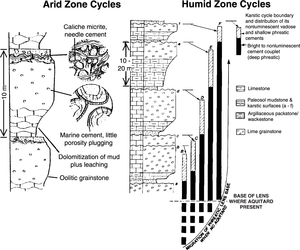Sequences during moderate-amplitude, high-frequency cycles
| Exploring for Oil and Gas Traps | |

| |
| Series | Treatise in Petroleum Geology |
|---|---|
| Part | Predicting the occurrence of oil and gas traps |
| Chapter | Predicting reservoir system quality and performance |
| Author | Dan J. Hartmann, Edward A. Beaumont |
| Link | Web page |
| Store | AAPG Store |
Fourth- or fifth-order moderate sea level cycles (20–50 m) occurred when global climate was transitional between major continental glaciation (commonly but not necessarily icehouse times) and greenhouse times.[1] Arid and humid zones existed simultaneously at different parts of the globe during transitional periods.
General characteristics
The following are general characteristics of fourth- and fifth-order carbonate sequences deposited during transitional periods:[1]
- More shingled and less layer caked than low-amplitude sequences
- Platform tops and ramps of greater slope than greenhouse platforms
- Grainstones widespread due to lateral migration, particularly on ramps
- Rare tidal-flat facies
- Regionally mappable disconformities on sequence tops
- Abundant siliciclastics in bases and/or tops of sequences of land-attached platforms
- Primary porosity greatest in grainy upper parts of sequences and thicker length::(10 m or more) than greenhouse sequences
- Muddy lower parts of sequences as internal flow barriers
Arid zone characteristics
Characteristics of carbonates deposited in arid zones are as follows:[1]
- Porosity in the sequence tops plugged by caliche and vadose fibrous cements
- Porosity in subtidal grainy parts of sequences generally lacks early sparry cements; primary porosity preserved where marine fringing cement present
- Top and lateral seals may form where peritidal dolomite and evaporite prograde over third-order sequences
An example is the Upper Mississippian ramp reservoirs of the eastern and central United States.
Humid zone characteristics
Following are characteristics of carbonates deposited in humid zones:[1]
- Tops may show karsting and soil development
- Grains in the upper part of sequences may undergo dissolution, and moldic or vuggy pores develop
- Vadose and upper phreatic sparry calcite cement often plugs primary and secondary porosity in the upper parts of sequences
- Primary porosity may be greatest in the middle or lower parts of sequences
- Meteoric diagenesis extends down into underlying older sequences because of deep groundwater zones; internal barriers may mitigate the effect
Examples are the British Dinantian (Mississippian) platforms.
Arid vs. humid zone sequences

The diagram in Figure 1 compares moderate-amplitude carbonate sequences from arid zones with carbonate sequences from humid zones. Arid zone grainstones tend to be oolitic, while humid zone grainstones tend to be skeletal. Humid zone sequences show the effects of repeated sea level changes by their distinctive cement zones precipitated in thick meteoric water lenses.
See also
- Predicting carbonate porosity and permeability
- Carbonate facies
- Carbonate diagenesis
- Carbonate diagenetic stages
- Early carbonate diagenesis
- Basics of carbonate porosity formation and preservation
- Sea level cycles and carbonate sequences
- Sea level cycles and carbonate diagenesis
- Sea level cycles and climate
- Sequences during low-amplitude, high-frequency cycles
- Sequences during high-amplitude, high-frequency cycles
- Predicting carbonate reservoir location and quality
References
- ↑ 1.0 1.1 1.2 1.3 1.4 Read, J. F., 1995, Overview of carbonate platform sequences, cycle stratigraphy and reservoirs in greenhouse and ice-house worlds, in Read, J. F., Kerans, C., Webber, L. J., Sarg, J. F., Wright, F. M., eds., Milankovitch Sea-level Changes, Cycles, and Reservoirs on Carbonate Platforms in Greenhouse and Ice-house Worlds: SEPM Short Course 35, 183 p. Good summary of concepts of climatic effect on sea level cycles, carbonate deposition, and reservoir development.